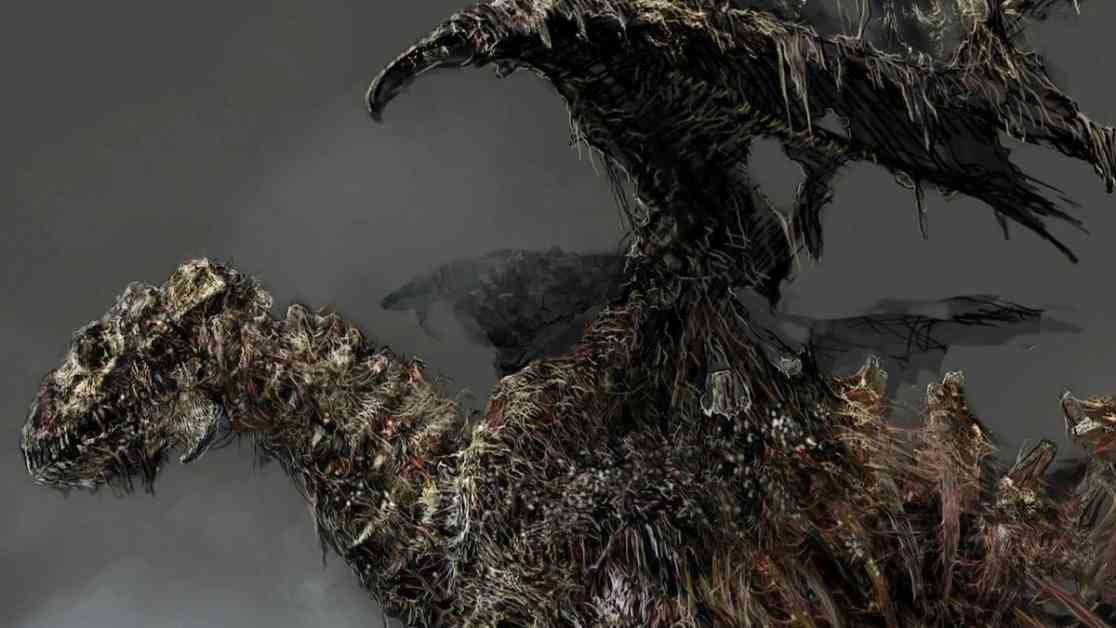There may be no more effective way to tank a conversation than trying to explain a meme, but screw it—I knew I had to try. When I visited FromSoftware’s offices in Tokyo to interview company president Hidetaka Miyazaki for PC Gamer’s next cover story, I knew I had to ask him about my favorite bit of trivia from Dark Souls: the instructions he gave to the artist behind the Undead Dragon. It may be my favorite quote from any videogame creator, and I know I’m not alone in loving it, because I see this quote from the Dark Souls: Design Works book passed around all the time as an example of what makes FromSoftware’s games so special. But to my knowledge Miyazaki’s never spoken about the quote since—I wasn’t even sure if he knew it had become a bit of a legend on the English internet. So I plowed in headfirst, reading him the quote—reproduced below—and then asking if he knew that it was now often used as shorthand to express the ethos of FromSoftware’s games.
From Dark Souls Design Works:
“Hidetaka Miyazaki: Most people don’t believe me when I say this, but a certain kind of refinement, elegance, and dignity are very important to me. I’ll usually tell the designers that flat-out grotesque or splatter type designs will not get past me. This has everything to do with my own personal sensibilities, and it is something that I apply to every design that I approve. It’s a little hard to describe if you were to ask me, ‘Well, what do you mean by dignity?’ I guess the best answer I can provide is right here in this book, in every design you see within these pages. My idea of dignity is something that I pursue with every project I work on and not just Dark Souls.”
Masanori Waragai: I remember when I was drawing the Undead Dragon, I submitted a design draft that depicted a dragon swarming with maggots and other gross things. Miyazaki handed it back to me saying, ‘This isn’t dignified. Don’t rely on the gross factor to portray an undead dragon. Can’t you instead try to convey the deep sorrow of a magnificent beast doomed to a slow and possibly endless descent into ruin?'”
Miyazaki chuckled when I mentioned Waragai’s name, so I had a feeling he knew where I was going with the question. But his follow-up was everything I could’ve hoped for.
“This is my personal ethos or approach to aesthetics—it doesn’t necessarily speak to the whole company,” Miyazaki said. “There are others with their own ideals and own aesthetic. But yes, it’s something I’ve tried to maintain with Elden Ring as well, that approach to design. I think what I’m trying to do is depict something beautiful, at the end of the day. How you interpret beautiful is obviously in the eye of the beholder; it doesn’t necessarily have to be something physically charming or outwardly beautiful. It can be something inside that lets you empathize with them on a deeper level.
“To be realistic, I feel something beautiful needs something ugly—something that’s depraved or tragic to heighten and embolden that beauty. I think that’s a much more realistic depiction of beauty, to have something small and beautiful inside something tragic and decaying. Something that’s just plainly, outwardly always beautiful doesn’t have a sense of reality to me. I like to try to create something beautiful within that tragedy.”
While I didn’t have time to ask how exactly this aesthetic approach applies to Shadow of the Erdtree, I don’t think Miyazaki would’ve spoiled anything FromSoftware hasn’t already shown from the Elden Ring expansion. But if I had to guess, I’d say that when we finally catch up to Miquella, who we’re looking for in the Land of Shadow, he’s going to exemplify the beautiful-but-gross mantra Miyazaki lives by.
Additional Information:
The article highlights how Hidetaka Miyazaki, the president of FromSoftware, emphasizes the importance of creating beauty within tragedy in his game designs. This approach adds depth and a sense of realism to the aesthetics of the games. By incorporating elements of ugliness and decay alongside beauty, Miyazaki believes that the overall portrayal becomes more poignant and relatable to players. This unique perspective on aesthetics sets Miyazaki’s games apart and resonates with fans of FromSoftware’s work.

